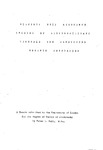ELECTRON SPIN RESONANCE STUDIES OF ALUMINOSILICATE MINERALS AND ASSOCIATED ORGANIC SUBSTANCES
| dc.contributor.author | HALL, PETER L. | |
| dc.contributor.other | School of Geography, Earth and Environmental Sciences | en_US |
| dc.date.accessioned | 2013-10-08T08:34:36Z | |
| dc.date.available | 2013-10-08T08:34:36Z | |
| dc.date.issued | 1972 | |
| dc.identifier | NOT AVAILABLE | en_US |
| dc.identifier.uri | http://hdl.handle.net/10026.1/2070 | |
| dc.description.abstract |
This thesis is divided into seven chapters. The first chapter describes the basic principles of electron spin resonance (ESR) spectroscopy. In the second chapter, relevant previous studies of clay minerals are reviewed, including a summary of previous studies by optical, Mössbauer and ESR spectroscopy of iron and other transition metal impurities in clay minerals. The third chapter reviews previous ESR studies of Fe³˖ ions in aluminosilicate minerals and other materials. The fourth chapter reviews the nature and properties of organic substances associated with natural clays and carbonaceous materials, emphasis being placed on the occurrence of organic free radicals and transition metal complexes in these materials as revealed by ESR spectroscopy. | |
| dc.language.iso | en | en_US |
| dc.publisher | University of Plymouth | en_US |
| dc.title | ELECTRON SPIN RESONANCE STUDIES OF ALUMINOSILICATE MINERALS AND ASSOCIATED ORGANIC SUBSTANCES | en_US |
| dc.type | Thesis | |
| plymouth.version | Full version | en_US |
| dc.identifier.doi | http://dx.doi.org/10.24382/3348 | |
| dc.identifier.doi | http://dx.doi.org/10.24382/3348 |
Files in this item
This item appears in the following Collection(s)
-
01 Research Theses Main Collection
Research Theses Main


